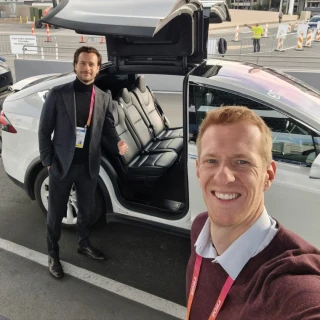In January 2023, a team of delaware experts crossed the Atlantic to CES, the annual trade fair for consumer electronics in Las Vegas to meet up with both new and well-established OEMs and suppliers. The objective? Validate their vision of where the automotive industry is going, what its specific pain points are, and what today’s key success factors are.
From momentum to value investing
“Overall, major players like Mercedes and GM are doing pretty well,” says senior consultant automotive Xander Verplancke. “Yet, in an effort to protect their margins, they are more than ever looking to reduce their costs. As a result, these OEMs are putting a lot of pressure on suppliers to bring component prices down. Meanwhile, these suppliers desperately need sufficient profits to reinvest in innovation, ensuring they remain both relevant and competitive.”
At the same time, numerous emerging OEMs are struggling to get the necessary funding to establish a sustainable business. “Attracting investment is challenging in the current economic climate,” adds solution lead automotive Tim Busschaert. “In the past few years, there’s been a clear shift from ‘momentum’ investing to ‘value’ investing. What this means is that younger companies are forced to contain spend and prove their profitability with the resources they currently have. That’s a challenging position.”
Race for standardization
‘Doing more with less’ or ‘making optimal targeted investments’ – whatever you want to call it, suppliers and emerging automotive brands will have to reach unprecedented levels of efficiency to survive in today’s automotive industry, where the expected level of professionalism is high, and legal requirements are incredibly strict.
“Even as a newcomer, you need to adhere to standardized industry-specific processes meticulously,” says Xander. “This includes best practices for assessing parts quality, preparing for vehicle testing and validation, clearing customs during transportation, all the way to providing top-notch aftersales services. As it’s impossible to immediately excel in each of these areas from the get-go, making the right investments at the right time is absolutely critical.”


/automotive-media_circle_square-1080x1080-(1).webp?mode=autocrop&w=320&h=240&attachmenthistoryguid=494298b8-57df-4110-8e37-e31542a2b7f3&v=&focusX=540&focusY=540&c=5e1ef1cc41d2669a996b7622ee44c0e6460a60770d18cb8505e822b1f77e5c10)




/automotive-banner-3200x500-(1).webp?mode=autocrop&w=320&h=240&attachmenthistoryguid=98a4a3fe-169e-4884-91bc-1447aba072bc&v=&focusX=2322&focusY=314&c=a3ba73541d80e848471c695c7b43e83667eb6d47f43b3ba486465c34eefc11e3)